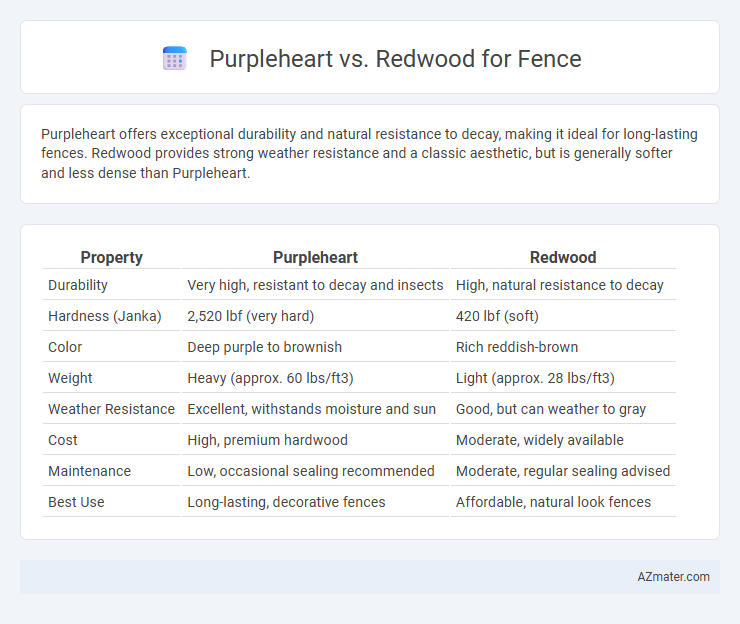Purpleheart offers exceptional durability and natural resistance to decay, making it ideal for long-lasting fences. Redwood provides strong weather resistance and a classic aesthetic, but is generally softer and less dense than Purpleheart.
Table of Comparison
| Property | Purpleheart | Redwood |
|---|---|---|
| Durability | Very high, resistant to decay and insects | High, natural resistance to decay |
| Hardness (Janka) | 2,520 lbf (very hard) | 420 lbf (soft) |
| Color | Deep purple to brownish | Rich reddish-brown |
| Weight | Heavy (approx. 60 lbs/ft3) | Light (approx. 28 lbs/ft3) |
| Weather Resistance | Excellent, withstands moisture and sun | Good, but can weather to gray |
| Cost | High, premium hardwood | Moderate, widely available |
| Maintenance | Low, occasional sealing recommended | Moderate, regular sealing advised |
| Best Use | Long-lasting, decorative fences | Affordable, natural look fences |
Introduction to Purpleheart and Redwood Fencing
Purpleheart and Redwood are both prized woods for fencing due to their durability and aesthetic appeal. Purpleheart offers a unique rich purple hue that intensifies with exposure and is highly resistant to decay and insect damage. Redwood is known for its natural resistance to moisture and rot, showcasing warm reddish tones that enhance outdoor spaces while requiring minimal maintenance.
Origin and Availability of Purpleheart and Redwood
Purpleheart, sourced primarily from tropical rainforests in Central and South America, is known for its vibrant purple hue and dense, durable wood. Redwood originates from the coastal regions of Northern California and Southern Oregon, prized for its natural resistance to decay and attractive reddish color. While Redwood is more readily available in the United States and often harvested sustainably from managed forests, Purpleheart is less common due to strict export regulations and ecological concerns, making it a rarer choice for fencing materials.
Durability and Lifespan Comparison
Purpleheart wood offers exceptional durability with natural resistance to decay, insects, and harsh weather, making it ideal for fencing with a lifespan typically exceeding 40 years when properly maintained. Redwood also provides strong durability due to its natural tannins and oils that protect against rot and insects, sustaining a fence lifespan of approximately 20 to 30 years under similar conditions. Comparing both, Purpleheart's denser, harder structure ensures superior longevity and wear resistance over Redwood, especially in demanding outdoor environments.
Resistance to Weather and Insects
Purpleheart wood exhibits superior resistance to weather and insects due to its dense, oily composition, making it highly durable for outdoor fencing. Redwood, while naturally resistant to decay and insect damage because of its tannins, requires more maintenance and is less dense, which can lead to faster weathering over time. Choosing Purpleheart ensures longer-lasting protection against harsh elements and pests, making it ideal for weather-exposed fences.
Aesthetic Appeal: Color and Grain Differences
Purpleheart offers a rich, deep purple hue that darkens over time, creating a striking and unique aesthetic for fences. Redwood features a warm, reddish-brown color with straight, pronounced grain patterns that evoke a classic and natural look. The vibrant, exotic appearance of Purpleheart contrasts with Redwood's traditional elegance, making each wood ideal for distinct design preferences and outdoor decor styles.
Environmental Impact and Sustainability
Purpleheart and Redwood differ notably in environmental impact and sustainability; Purpleheart is sourced from tropical hardwood forests often subjected to stricter regulations and certifications like FSC, promoting sustainable harvesting, whereas Redwood is native to the western United States with many plantations and reforestation programs ensuring long-term forest health. Redwood's fast growth and natural resistance to decay reduce the need for chemical treatments and frequent replacements, enhancing its eco-friendliness compared to Purpleheart, which, despite durability, requires longer transport distances increasing carbon footprint. Choosing sustainably harvested Redwood with verified certifications supports environmental conservation efforts more directly than Purpleheart, making it a preferred option for eco-conscious fence construction.
Installation and Maintenance Requirements
Purpleheart fencing offers superior durability and requires minimal maintenance due to its natural resistance to decay and insect damage, making installation straightforward with fewer concerns about long-term upkeep. Redwood, while also relatively easy to install, demands regular sealing or staining to preserve its aesthetic appeal and prevent weather-related deterioration. Choosing Purpleheart reduces ongoing maintenance efforts but may involve a higher initial installation cost compared to Redwood, which benefits from widespread availability and lighter weight.
Cost Comparison: Purpleheart vs Redwood
Purpleheart wood typically costs more than redwood due to its exotic origin and exceptional durability, with prices ranging from $15 to $25 per board foot compared to redwood's average of $10 to $18 per board foot. Redwood is generally more affordable and widely available, making it a popular choice for budget-conscious fencing projects. However, the higher initial investment in purpleheart may be offset by its greater resistance to decay and insects, potentially reducing long-term maintenance expenses.
Best Use Cases for Each Wood Type
Purpleheart is ideal for fencing projects requiring exceptional durability and resistance to decay, thriving in high-moisture or insect-prone environments due to its dense, hardwood properties. Redwood excels in decorative and residential fencing, offering natural resistance to rot and a rich, warm color that enhances curb appeal while being easier to work with and maintain. For heavy-duty or commercial fencing, Purpleheart's strength makes it a superior choice, whereas Redwood suits aesthetic-driven applications and moderate durability needs.
Conclusion: Which Wood is Better for Your Fence?
Purpleheart offers exceptional durability and vibrant color retention, making it an ideal choice for a long-lasting and visually striking fence. Redwood provides natural resistance to decay and insects with a classic appearance, often preferred for its ease of workability and traditional aesthetic. For a fence requiring maximum longevity and unique color, Purpleheart is better; for a more conventional look with proven weather resistance and easier installation, Redwood is the optimal wood choice.

Infographic: Purpleheart vs Redwood for Fence
 azmater.com
azmater.com